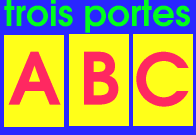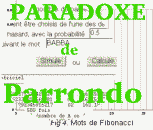
Accueil
Plan du site
Bloc notes
Jeux
Graphes
Combinatoire
Arithmétique
Algèbre
Analyse
Probabilités
Automates
Programmation
Divers
Liens
Home
Plan du site
Bloc notes
Jeux
Graphes
Combinatoire
Arithmétique
Algèbre
Analyse
Probabilités
Automates
Programmation
Divers
Liens
Home
Probabilités - Probability
| SOMMAIRE | Pages Web | Associations | Pages Personnelles | Logiciels | Sources | Java |
| Javascript | Tests | Livres | Sujets | Papiers | Cours | Tutoriels | Historiques |
| Biographies | Arts | Liens |
| Javascript | Tests | Livres | Sujets | Papiers | Cours | Tutoriels | Historiques |
| Biographies | Arts | Liens |
LOI BIN�MIALE
Vous obtiendrez un diagramme en b�tons des valeurs des probabilit�s P(X=k).
PAGES WEB

Trois portes
Monty Hall - with Applet
jean-Paul Davalan
<http://perso.wanadoo.fr/jean-paul.davalan/proba/parr/index-en.html>
The Probability Web is a collection of probability resources on the World Wide Web (WWW).
<http://www.mathcs.carleton.edu/probweb/probweb.html>
David Madore
Naissances en Chine. Une fille à la porte. Les portes au trésor. les réflexions du prisonnier. Un jeu stupide. le jeu de « moitié ou double ». Avec une somme minimum. Un singe et une machine à écrire. loi exponentielle. Processus de Poisson. « paradoxe des intervalles ». « paradoxe de translation »
<http://www.eleves.ens.fr:8080/home/madore/math/proba.html>
Kyle Siegrist Department of Mathematical Sciences University of Alabama in Huntsville
<http://www.fmi.uni-sofia.bg/vesta/Virtual_Labs/>
trois portes, paradoxes de Parrondo, de Bertrand. Allumettes de Banach. Dés non transitifs. Les chapeaux. Loi binômiale. Loi de Laplace-Gauss (table .ps .pdf, source .c). Filtres superposables. Nombres premiers probables. Pi (Monte Carlo). Graphes probabilistes. Matrices de transition.
<http://perso.wanadoo.fr/jean-paul.davalan/proba/index.html>
The Black-Scholes equation for the fair value of a European call option on a nondividend paying stock is C=SN(d1)-Xe^(-rt)N(d2) where C call option price, S current stock pr. X exercise pr.
<http://risk.ifci.ch/00010552.htm>
(and related distributions, such as the skew-t)
(ndlr : skew-normal distribution = distribution normale asymétrique)
<http://azzalini.stat.unipd.it/SN/>

Le Paradoxe de Parrondo
ASSOCIATIONS
Random.org offers true random numbers to anyone on the internet.
<http://www.random.org/>
PAGES PERSONNELLES - HOME PAGES
Omnia digna facere digna sunt facere male
<http://www.math.dartmouth.edu/~doyle/>
LOGICIELS - SOFTWARES
A Server on the Theory and Practice of Random Number Generation
by a team of mathematicians and computer scientists led by Peter Hellekalek at the University of Salzburg's Mathematics Department.
<http://random.mat.sbg.ac.at/>
<http://archive.ncsa.uiuc.edu/Apps/CMP/RNG/www-rng.html>
<http://www.taygeta.com/random.xml>
<http://www.helsbreth.org/random/>
Michael Hennecke
<http://www.uni-karlsruhe.de/~RNG/>
<http://www.netlib.org/random/>
lois normale et exponentielle
<http://www.jstatsoft.org/v05/i08/>
SOURCES
R250 (very long period : 2^259)
<http://www.taygeta.com/random.xml>
JAVA
A nice collection of probability applets (including the Birthday problem, Banach's matchbox, and Traffic Jams); they may seem simple at first but they're always surprising...
<http://www-stat.stanford.edu/~susan/surprise/>
The Probability/Statistics Object Library is a resource for teachers and students of probability and statistics. The library contains objects of two basic types: applets, and components.
<http://www.math.uah.edu/psol/>
Stanford. Welcome to Probability by Surprise. Susan Holmes.
<http://www-stat.stanford.edu/~susan/surprise/Banach.html>
Jean-Paul Davalan
<http://perso.wanadoo.fr/jean-paul.davalan/proba/index.html>
Danby Package for probability and statistics applets
utilisé par The Hypergeometric Distribution
<http://www.math.csusb.edu/faculty/stanton/danby/danby_package.html>
JAVASCRIPT
J-P Davalan
Problème simple mais peu intuitif des trois portes. Lors d'un jeu télévisé (Let's Make a Deal!), le présentateur (Monty Hall) montrait trois portes fermées au candidat et affirmait que derrière l'une d'entre-elles se cachait un cadeau (une voiture) et qu'il suffisait d'indiquer la bonne porte pour gagner.
<http://perso.wanadoo.fr/jean-paul.davalan/proba/index.html>
<http://home.ubalt.edu/ntsbarsh/Business-stat/otherapplets/ANOVATwo.htm#rmenu>
TESTS
A collection of classical pseudorandom number generators with linear structures - advanced version
Karl Entacher
This is a collection1of selected linear pseudorandom number generators that were implemented in commercial software, used in applications, and some of which have extensively been tested. The quality of these generators is examined using scatter plots and the spectral test.
<http://random.mat.sbg.ac.at/results/karl/server/>
LIVRES - BOOKS
Ce livre est écrit pour tous ceux qui, en suivant un enseignement scientifique, ont éprouvé le sentiment typique qu'il manquait quelque chose d'essentiel, qui aurait permis de vraiment comprendre. Il ne s'adresse donc qu'à ceux qui veulent réellement comprendre.
<http://moire4.u-strasbg.fr/bouquins/proba/tabmat1.htm>
Ross Kindermann and J. Laurie Snell, American Mathematical Society, 1980, 142pp.,
<http://www.ams.org/online_bks/online_subject.html#PR>
SUJETS - SUBJECTS
Moché, Raymond - IREM Lille
<http://www.univ-lille1.fr/irem/publications/fascicules.htm>
Michel Ãmery
1 Le paradoxe de Simpson. 2 Dites : << Rouge >> 3 Deux enveloppes (première version). 4 Deux enveloppes (seconde version).
<http://irem.u-strasbg.fr/irem/ouvert/Ouvert104Pdf/emery.pdf>
Par Salvatore Tummarello, Futura-Sciences
Pour ses « contributions fondamentales à la théorie des probabilités et en particulier à la création d'une théorie unifiée des grandes déviations », le mathématicien indien Srinivasa S. R. Varadhan, âgé de 67 ans, a vu sa carrière couronnée par le prix Abel 2007...
<http://www.futura-sciences.com/fr/sinformer/actualites/news/t/mathematiques-1/d/prix-abel-2007-le-pere-de-la-theorie-des-grandes-deviations-recompense_10614/>
DOCUMENTS - PAPERS
<http://pass.maths.org.uk/subject.shtml#Probability>Benford's Law (which was first stated by Simon Newcomb in 1881) states that if you randomly select a number from a table of physical constants or statistical data, the probability that the first digit will be a "1" is about 0.301, rather than 0.1 as we might expect if all digits were equally likely.
<http://www.seanet.com/~ksbrown/kmath302.htm>
Article by Joe Celko
<http://www.gamecabinet.com/rules/Dice.html>
Dr. Everett F. Carter Jr.
<http://www.taygeta.com/rwalks/rwalks.html>
by David H. Bailey and Richard E. Crandall
We propose a theory to explain random behavior for the digits in the expansions of fundamental mathematical constants.bcrandom.ps
<http://www.perfsci.com/free/techpapers/freepapers.html#random >
We consider the requirements for a good parallel random number generator, discuss generators for the uniform and normal distributions, and describe a new class of generators for the normal distribution, based on a proposal by Chris Wallace ps
<http://web.comlab.ox.ac.uk/oucl/work/richard.brent/pub/pub185.html>
Olga Holtz, Fedor Nazarov, Yuval Peres
<http://arxiv.org/abs/0808.1936>
COURS - COURSES
Calcul des probabilités et Introduction aux processus aléatoires
M.Nikulin V.Bagdonavi·cius V.Nikoulina
<http://www.sm.u-bordeaux2.fr/ufr/Files/Polys/nikouline-licence.pdf>
<http://perso.libertysurf.fr/mathslinker/M_sp_f.htm>
Laurent Mazliak
<http://www.proba.jussieu.fr/users/lma/enseignement.html>
documents pédagogiques cours, annales
N. Limnios - Universite de Technologie de Compiègne - Département Génie Informatique - Laboratoire de Mathématiques Appliquées.
<http://www.gi.utc.fr/sy01/index.php?page=p_docu>
Polycopié : Proba_ENPC_2000.ps.gz
<http://www.enpc.fr/cereve/HomePages/mcdl/proba/>
Calculs en ligne Hubert Bayet, Rochefort
<http://www.ac-poitiers.fr/math/prof/resso/cali/ic_phrek.html>
is a text for a first course in probability. It is a revision of an earlier book written by the second author and published by McGraw Hill.
<http://www.dartmouth.edu/~chance/teaching_aids/books_articles/probability_book/book.html>
by Russell Lyons with Yuval Peres
<http://php.indiana.edu/~rdlyons/prbtree/prbtree.html>
John G. Kemeny, J. Laurie Snell, and Gerald L. Thompson
<http://math.dartmouth.edu/~doyle/docs/finite/cover/cover.html>
Jean BROSSARD et Christophe LEURIDAN
<http://www-fourier.ujf-grenoble.fr/PREP/html/a442/a442.html>
Statistique descriptive Systèmes itératifs discrets Simulation des variables aléatoires Lois de probabilité usuelles
<http://www.math-info.univ-paris5.fr/~ycart/polys_ycart.html>
probabilité et statistique de DEUG 2eme année de sciences de la vie, Méthodes mathématiques pour les sciences de la vie I du DEUG de sciences de la vie, probabilité et statistique de la maîtrise de biomathématiques de luminy, les chaînes de Markov du DEA Environnement marin, cours d'introduction aux statistiques appliquées (orienté agronomie), complément sur les processus.
<http://ms451u07.u-3mrs.fr/avner/avner.html>
<http://math.univ-bpclermont.fr/stflour/published.htm>
TUTORIELS - TUTORIALS - TUTORS
<http://www-math.bgsu.edu/~albert/m115/probability/outline.html>by Dr Noel Vaillant
<http://www.probability.net/>
Dr. John L. Stensby
<http://www.eb.uah.edu/ece/courses/ee420-500/>
HISTORIQUES - HISTORY
<http://math.dartmouth.edu/~doyle/docs/hazard/scan/hazard.pdf>BIOGRAPHIES
La page des documents par exemple, présente au lecteur certains aspects historiques des Mathématiques - Wolfgang Doeblin (1915-1940) En arrivant au 15ème chapitre du cahier consacré à l équation de Kolmogorov, Marc Yor s'est aperçu que Doeblin était sur la voie des découvertes du mathématicien japonais Ito en 1944 : « Ito a eu une idée de génie, qui a mis vingt-cinq ans à être acceptée. Je pensais que personne ne l'avait eue avant. En fait, il suffisait de bien lire le cahier de Doeblin. »
<http://mathematiques.fauriel.org/>
University of St Andrews, Scotland
<http://www-groups.dcs.st-and.ac.uk/~history/BiogIndex.html>
<http://www.tld.jcu.edu.au/hist/stats/quet/index.htm>
ARTS
Stéphane Mallarmé
Peter G. Doyle Derived from a public domain work originally published in 1914
<http://math.dartmouth.edu/~doyle/docs/coup/cover/cover.html>
LIENS - LINKS
<liens_math.html> <http://members.aol.com/johnp71/javasta4.html>
| SOMMAIRE | Pages Web | Associations | Pages Personnelles | Logiciels | Sources | Java |
| Javascript | Tests | Livres | Sujets | Papiers | Cours | Tutoriels | Historiques |
| Biographies | Arts | Liens |
| Javascript | Tests | Livres | Sujets | Papiers | Cours | Tutoriels | Historiques |
| Biographies | Arts | Liens |
| Accueil | Plan du site | Bloc notes | Jeux | Graphes | Combinatoire | Arithmétique | Algèbre |
| Analyse | Probabilités | Automates | Informatique | Divers | Lycée |
| Analyse | Probabilités | Automates | Informatique | Divers | Lycée |
Advertising :
If you see a reference in one of the files that is not linked, and you know of a link address to the appropriate document,
please send me mail, and I will include the link in the document. Thanks very much in advance.
Avertissement : Le classement par catégories est approximatif. Certains liens se retrouvent dans des rubriques différentes et sur plusieurs pages. Les commentaires sont généralement des courts extraits des pages référencées. Il est possible que certains liens nécessitent une mise à jour.
Tous commentaires ou remarques sont les bienvenus, vous pouvez les adresser à :

Les mises à jour demandées sont réalisées dès que possible et, sauf si c'est nécessaire, aucun message de réponse n'est expédié. Merci de m'écrire.
Copyright © 1999-2012 Jean-Paul Davalan - Reproduction interdite.
Avertissement : Le classement par catégories est approximatif. Certains liens se retrouvent dans des rubriques différentes et sur plusieurs pages. Les commentaires sont généralement des courts extraits des pages référencées. Il est possible que certains liens nécessitent une mise à jour.
Tous commentaires ou remarques sont les bienvenus, vous pouvez les adresser à :

Les mises à jour demandées sont réalisées dès que possible et, sauf si c'est nécessaire, aucun message de réponse n'est expédié. Merci de m'écrire.
Copyright © 1999-2012 Jean-Paul Davalan - Reproduction interdite.